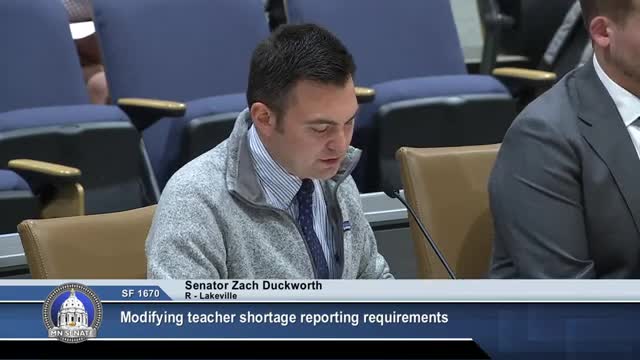Senate Bill 1670 aims to redefine teacher shortage metrics in Minnesota
March 22, 2025 | Education Policy, Senate, Committees, Legislative, Minnesota
Thanks to Scribe from Workplace AI , all articles about Minnesota are free for you to enjoy throughout 2025!

This article was created by AI using a video recording of the meeting. It summarizes the key points discussed, but for full details and context, please refer to the video of the full meeting. Link to Full Meeting
Matt Shaver, a senior policy director at Ed Allies and a licensed teacher, presented Senate File 1670, which aims to refine how the state measures teacher shortages. Shaver emphasized that while the existence of a teacher shortage is widely acknowledged, the current methods of measurement are inadequate. He pointed out that the term "teacher shortage" appears in various legislative contexts but is only clearly defined in a couple of instances. This lack of clarity complicates efforts to address the issue effectively.
Currently, Minnesota's approach to measuring teacher shortages relies heavily on the number of tiered teachers in classrooms, which can misrepresent the actual situation. For instance, if a tier 2 teacher leaves mid-year, the reported shortage may appear to decrease, despite the vacancy remaining unfilled. Shaver argued that many states, including Colorado and Illinois, utilize more comprehensive data, such as actual vacancy counts, to inform their understanding of teacher shortages. This data is crucial for developing targeted policies that address disparities in schools, particularly those serving high populations of students of color and those from low-income backgrounds.
The committee's discussions underscored the importance of establishing a legislative definition of teacher shortages and collecting robust data to inform policy decisions. Shaver's testimony highlighted that Minnesota's current data collection methods are insufficient, relying on a simple yes or no question about unfilled positions, which fails to capture the full extent of the problem.
As the committee continues to explore solutions, the proposed bill seeks to create a more holistic understanding of teacher shortages, enabling lawmakers to craft effective policies and allocate resources more strategically. The discussions from this meeting reflect a growing recognition of the need for actionable data in addressing educational challenges in Minnesota.
Converted from Committee on Education Policy - 03/19/25 meeting on March 22, 2025
Link to Full Meeting
Comments
View full meeting
This article is based on a recent meeting—watch the full video and explore the complete transcript for deeper insights into the discussion.
View full meeting
